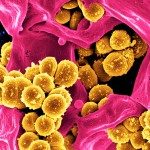Lien vers Pubmed [PMID] – 8313371
Cancer Res. 1994 Feb;54(4):861-6
We have studied expression of the urokinase receptor (u-PAR) in paraffin-embedded breast tissues at various stages of malignant progression. Forty-nine of 59 invasive cancers studied showed varying degrees of reactivity with our polyclonal antibody. The staining pattern was variable from case to case, although strong surface staining of tumor-associated macrophages was evident in most of these sections. In several cases, blood vessels in selected tumor areas were stained, as confirmed by treatment of adjacent sections with an anti-factor VIII antibody. These could represent regions of recent angiogenesis. Staining of tumor cells was observed in 21 of 59 cases and was extensive in 5 cases but confined to a small percentage of cells in the remaining 16 samples. In contrast with the cancer sections, all normal breast tissue (12 cases) was negative, as well as all fibroadenomas (4 cases), papillomas (5 cases), and hyperplasia with atypia (2 cases) studied. Seven carcinomas in situ examined were also negative for u-PAR, with the exception of few macrophages in two cases, suggesting that u-PAR expression may be associated with invasive tumor. The presence of u-PAR in human breast cancer and its absence from nonmalignant breast tissue supports the idea that plasminogen activation plays an important role in the process of cancer invasion. Expression of u-PAR on macrophages, endothelial cells, and cancer cells suggests the existence of complex paracrine interactions between tumor cells and stroma.
